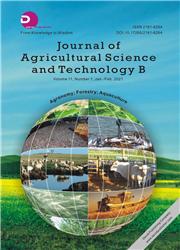Seed Scarification Improves Physiological Growth and Development of Bambara Groundnut (Vigna subterranea) Depending on Seed Coat Colour
引用次数: 0
Abstract
This study was conducted to investigate the effect of scarification on bambara groundnut (Vigna subterranea) physiological growth and development and crop phenology. Bambara groundnut landrace seeds used in this study were characterized by seed coat colour (cream, light brown and brown). Seed scarification treatments were mechanical (sand paper) and chemical (sulphuric acid) scarification, while seeds that were not scarified served as a control. A completely randomized design with three replications was used. The parameters that were assessed were time to emergence, final emergence percentage, leaf number, chlorophyll content index (CCI), canopy diameter, plant height, chlorophyll fluorescence (Fv/Fm), photosynthetic performance index (Pi), time to flowering and time to senescence. CCI, leaf number and plant height were significantly (p < 0.05) influenced by seed coat colour, seed scarification treatments and their interaction thereof. Seed scarification treatment had a significant effect on CCI, leaf number and plant height. Generally, seed scarification improved plant overall performance than the control. Chemical scarification presented superior performance of bambara groundnut growth and development. Light brown seeds produced plants with superior overall performance, having superior emergence, CCI, leaf number, and early flowering and senescence. Light brown seeds were followed by cream seeds in terms of superiority of plant performance, having produced plants with superior canopy diameter, plant height and Pi. Therefore, bambara groundnut farmers and researchers can successfully use scarification to improve its physiological growth and attain earlier phenological stages, hence maturity. At the same time, light brown seeds should be selected for cultivation to give the best plant performance.种子Scarification根据种皮颜色改善斑花花生的生理生长发育
研究了刈割对板栗生理生长发育及作物物候的影响。本研究使用的班巴拉乡土花生种子的种皮颜色为奶油色、浅棕色和棕色。种子刻痕处理分为机械(砂纸)和化学(硫酸)刻痕处理,而未刻痕的种子作为对照。采用完全随机设计,3个重复。评价参数为出苗期、终出苗率、叶片数、叶绿素含量指数(CCI)、冠层直径、株高、叶绿素荧光(Fv/Fm)、光合性能指数(Pi)、开花时间和衰老时间。种皮颜色、种子刻蚀处理及其交互作用显著影响CCI、叶片数和株高(p < 0.05)。种子刻蚀处理对CCI、叶片数和株高有显著影响。总的来说,种子割伤比对照提高了植株的整体性能。化学刻蚀对板栗生长发育有较好的影响。浅棕色种子的植株综合性能较好,出苗率、CCI、叶数、开花早、衰老早。在植株性能方面,浅棕色种子次之,奶油色种子的植株冠粗、株高和圆周率均较优。因此,班巴拉花生种植者和研究人员可以成功地利用刻痕来改善其生理生长,并达到更早的物候阶段,从而成熟。同时,应选择浅棕色种子进行栽培,以获得最佳的植株性能。
本文章由计算机程序翻译,如有差异,请以英文原文为准。
求助全文
约1分钟内获得全文
求助全文

 求助内容:
求助内容: 应助结果提醒方式:
应助结果提醒方式:


